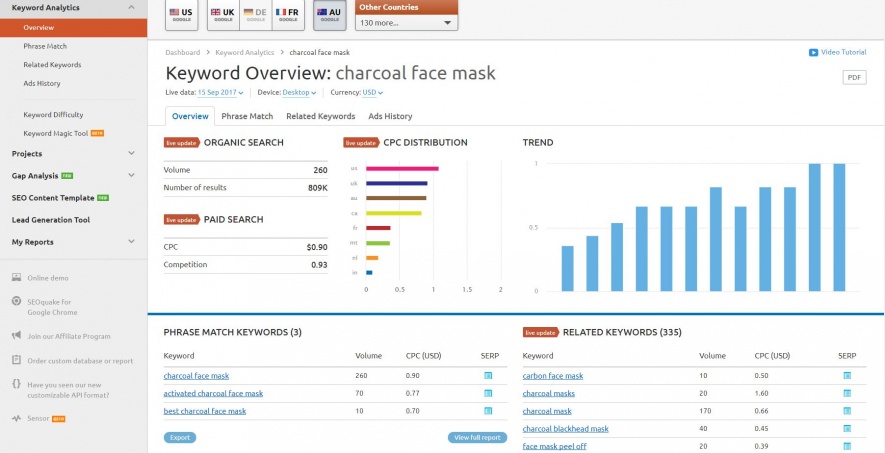Vahe Arabian Identifying Profitable Niches: Creating a Perfect Synergy Between SEO & Affiliate Marketing … Wow-Score collecting now The Wow-Score shows how engaging a blog post is. It is calculated based on the correlation between users’ active reading time, their scrolling speed and the article’s length. Learn more Identifying Profitable Niches: Creating a Perfect Synergy Between SEO & Affiliate Marketing
- 67
- 9
- 9
SEO and Affiliate Marketing: Can They Live in Harmony?
In the constant quest to drive traffic to your site and to get on the first page of search engine results, it sometimes seems as if SEO and affiliate marketers are at odds with one another.
A site starts to drop in Google rankings, and immediately blame starts flying around. It must be the fault of the affiliate links, which must be pulling down the SEO somehow! No, it's the fault of the keyword choices — someone isn't doing a good job of trying to game the Google algorithm!
The reality is that both affiliates and those on the SEO side are trying to achieve the same goal: Driving traffic to a site in a world in which everything is always in flux, i.e., customer needs and preferences, supply and demand, and oh yes, search engine algorithms.
The push-and-pull problem is clear. And there is a solution: niche marketing. But, first, let's take a look at the problem.
The Problem: The Clash Between SEO and Affiliate Marketing
Those who rely on SEO to drive traffic make an assumption: higher search rankings result in a greater number of conversions. Based on this assumption, they juggle their content, constantly trying to find the right combination of long-tail keywords to make Google sit up and pay attention.
Affiliate marketers are actually making a similar assumption but using different tactics. They believe that driving traffic through backlinks, influencers, and an understanding of traffic sources is what leads to conversions, so they are always looking for the right strategy that will combine these elements and lead to conversion success.
In reality, the two competing mindsets don't always work the way their proponents might wish. It is possible to achieve mind-blowing search rankings without seeing an uptick of conversions. It is also possible to set up the perfect affiliate relationships with all the "you pat my back, and I'll pat yours" that's involved and see conversion numbers remain flat.
It seems we need a third way. For many businesses, there is indeed a solution: identifying profitable niches that allow synergy between the tactics used by SEO and affiliate marketers.
The Solution: Identifying Profitable Niches
The concept of focusing on a niche market isn't a new one, especially for those publishing unique content. It goes back as far as Gutenberg cranking out books one at a time for the ultimate niche market of his day; those who knew how to read.
It is a durable strategy, though, because it is based on a durable concept, which is understanding the needs of a very specific audience so well that choosing products, services, and marketing tactics become second nature to you.
The value of finding a profitable niche is that niche audiences are loyal. They stick with you for the long-term rather than dashing off to see what's shiny and new on the next site.
So how do you identify a profitable niche?
1. Focus On the User
The internet has made it possible for people with niche passions to find one another — which means they are there to be found by marketers. Look for niche audiences by casting a wide net to find the tribes who have gathered together to share these passions.
Your initial list may be unbelievably broad, given the wide variety of possibilities:
- College frat bros.
- "Star Wars" fans.
- Backyard gardeners raising dwarf fruit trees.
- Women in Australia who use charcoal face masks.
- Aspiring stand-up comedians.
- Lovers of Shakespeare.
- Green Bay Packers "cheeseheads."
- Filmmakers working with micro-budgets.
You get the idea. And while the whole world of internet nichedom may seem overwhelming, you can start to narrow down your choices quickly. Focus on the topics you are interested in. Dive deep into the worlds you already know something about.
And when we say dive deep, we mean really deep. It is time now to focus on the people in those niche worlds. What are they afraid of? What problems do they face? What makes them happy? What do they aspire to?
And let's not forget the question that matters (to you, that is): What will they spend money on?
2. Not Just the Right Niche: The Profitable Niche
Let's face it, some niche audiences spend more money than others. That is the reason why you see so many affiliate marketing programs and networks like Commission Factory surrounding the fashion industry; It speaks to an audience who is always looking for something new and is ready to spend money to keep up with always-changing trends. That is an ideal market for any marketer (and as a result, it is already a crowded one).
But not all niches are as generous to marketers. Once you have got your list of niches that you are interested in focusing on, start winnowing out the less profitable ones. In each niche, an audience is willing to spend money to scratch an itch, either to solve a problem or to make themselves happy. But where are the niches where people are most willing to spend that money?
Now it is time to pull out all your analytic tools. You need to look at numbers of searches related to your chosen niche, the stability of the search terms and keywords employed, the number of competitors already trying to reach that niche, and (don't forget this part) the ability of the niche audience to scratch that itch without spending money.
Google Keyword Planner is your friend here, as is SEMrush's Keyword Analytics feature. You probably have your own favorite tools for searching keywords and digging through historical search data, but these are a couple of my favorites.

As you search, determine the minimum search volume threshold you need to drive traffic to your site — generally, 2,000 is a good starting place. You also need to pay attention to the trend curve. For example, while an enduring community of Harry Potter fans continue to thrive online, the peak for marketing to them passed between 2007 and 2011 when the final book and movie were released, making this a waning niche audience for a marketer to pursue.
Analyzing the profit value of various niche markets puts you in a position to tie SEO and affiliate tactics together.
SEO and Affiliate Tactics That Boost Niche Marketing
Ultimately, even though they approach the effort differently, both SEO and affiliate marketing rely on content to drive traffic. Both require content that is appealing enough to an audience to make people stop and read — and click — and buy.
Pulling tactics from both worlds is of value once you have identified a profitable niche to pursue. Take a look at some of the tried-and-true tactics you can use to profit from a synergy of SEO and affiliate marketing:
- Keywords. Keyword stuffing isn't going to help you with a niche market. You will need to research your keywords (you already did some of this in determining that your niche market is a profitable one), build your targeting relevancy through TF*IDF then track their ranking after you use them to tweak as appropriate.
- Linkbacks. Linkbacks are the linchpin of affiliate marketing, and when you focus on profitable niches, you can take advantage of them in a way that those focusing on SEO can only dream about. Of course, you can build links through an affiliate structure, but you don't have to rely on that once you have chosen a profitable niche. Instead, now you can create content that your audience wants to share and link to organically because you are feeding their passions, solving their problems, and meeting their needs. Influencer affiliate marketing is on the surge these days, especially due influencers pull to earn links from their followers and retailers product they are promoting.
- Unique Content. The days of cranking out "unique" content designed to fool a search engine and trick users into clicking through are gone. Truly unique content, however, is exactly what draws in your niche audience, who are always looking for more information (and more products and services) tied to their passions. Evergreen content drives searches organically, drawing traffic to your site.
- User-generated Content. Affiliate marketers have long known the value of creating a band of users who come to see a website as their home turf. When you provide opportunities for user-generated content through blog comments, surveys and the like, you increase customer engagement. In turn, all those user-based signals make their way back to Google. And don't forget to tie in your social media to let users have a voice and spread the word.
In Conclusion
When you identify a profitable niche, you have set the wheels in motion to start driving traffic to your site organically via both SEO and affiliate tactics. The original and unique content that you create to keep your niche audience intrigued generates keywords authentically, drawing in other members of the niche audience.
As members of the niche link to your relevant content on other sites, you end up with the kind of backlinks that also drive traffic — whether you choose to augment those with traditional affiliate marketing techniques or not. And because you are already appealing to an audience primed to satisfy their needs with what you are offering you increase conversions.

How do you find the perfect balance with Affiliate Marketing and SEO? Please leave your comments below.
SEO  Vahe Arabian Almost 8 years in organic search across startup agencies and freelancing, specialising in audience development, content strategy, digital analytics and technical SEO strategy.Read the original article here
Vahe Arabian Almost 8 years in organic search across startup agencies and freelancing, specialising in audience development, content strategy, digital analytics and technical SEO strategy.Read the original article here



